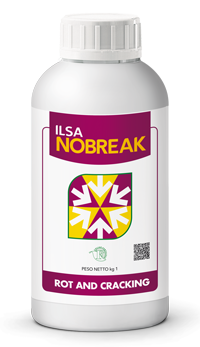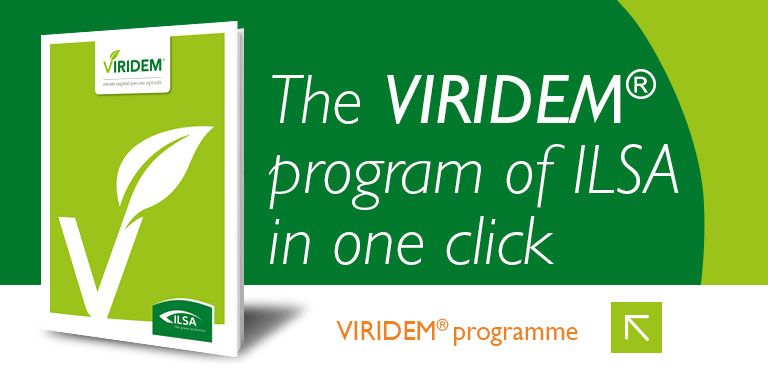PROMOTES FRUIT RESISTANCE
Fruit cracking happens when, due to imbalanced fertilisation or massive use of synthetic hormones, the inner part ofthe fruit grows more than the outer part. The ensuing strong pressure causes cracks in fruits, which results in a lossof value of final production. Weather events (water, hailstorm and thermal leaps) and incorrect water managementcan exacerbate this problem. Also, a few tree species, namely those benefiting greatly from the intake of calcium, organic nitrogen and amino acids, are very susceptible to cracking.
ILSANOBREAK is a special product designed to reduce cracking in fruit crops such as cherries, apples, plums, peaches,apricots and citrus.
The presence of protein-derived nitrogen, in addition to avoiding excessive fruit enlargement, allows ILSANOBREAK to provide specific amino acids (proline, hydroxyproline and glutamic acid in particular) that allow a smooth progressof the ripening stages. Also, calcium directly provided through leaves (since it hardly moves inside the plant) allowsincreasing the skin’s mechanical resistance and pulp consistency, for it both strengthens cell walls and membranesand makes them more elastic, by stimulating cell division and elongation.
ILSANOBREAK provides protein nitrogen, amino acids from enzymatic hydrolysis and calcium of very high quality,which are also fundamental to avoid qualitative defects in apples (bitter pit), pears, stone fruits and citrus, so ensuringa high quality of final production.
Chemical and physical features
- LIQUID AMBER YELLOW COLOUR
- pH 6,0 ± 0,5
- DENSITY 1,29 ± 0,02 kg/dm3
- CONDUCTIVITY 4,00 ± 0,20 dS/m
COMPOSITION
-
Total Nitrogen (N) 5 %
- Of which: Organic Nitrogen (N) 5 %
- Water soluble Calcium (CaO) (%w/w) 8 %
- Organic Carbon (C) 15 %
Contains in particular
- CO-FORMULANT FROM ENZYMATIC HYDROLYSIS
- CALCIUM
Characterising substances
- HIGHLY ASSIMILABLE CALCIUM, PROLINE, HYDROXYPROLINE, GLUTAMIC ACID
ACTIONS OF THE CHARACTERISING SUBSTANCES
| GREATER FINAL QUALITY | RESISTANT EPIDERMIS AND GREATER CONSISTENCY | |
|---|---|---|
| AMINO ACIDS FROM ENZYMATIC HYDROLYSIS |

|

|
| PROTEIN NITROGEN |

|
|
| HIGHLY ASSIMILABLE CALCIUM |

|

|
Doses and methods of use of the fertilizer
-
Citrus
-
All2,5 - 3 kg/ha2-4 applications every 10-15 days from fruit enlargement
-
-
Fruit
-
Pomegranate2-3 kg/ha2-4 applications every 10-15 days from fruit enlargement
-
-
GrapeVine
-
All2-2,5 kg/ha3-4 applications during berries enlargement, every 10-15 days
-
-
Olive Tree
-
All2-2,5 kg/ha2-3 applications, every 15-20 days, from the olive ripening phase (The end of August)
-
-
Pome fruits
-
Apple2,5 - 3 kg/ha2-4 applications every 10-15 days from fruit enlargement
-
Pear2,5 - 3 kg/ha2-4 applications every 10-15 days from fruit enlargement
-
-
Stone fruits
-
Apricot2-2,5 kg/ha2-4 applications every 10-15 days from fruit enlargement
-
Cherry2-3 kg/ha2-4 applications every 10-15 days from fruit enlargement
-
Nectarine2-2,5 kg/ha2-4 applications every 10-15 days from fruit enlargement
-
Peach2-2,5 kg/ha2-4 applications every 10-15 days from fruit enlargement
-
Plum2-2,5 kg/ha2-4 applications every 10-15 days from fruit enlargement
-
The dose indicated in the table has been calculated by taking into account an irrigation volume of about 500-600 litres of water per application. The doses shown should be considered as merely indicative and may vary according to pedoclimatic conditions and average yields expected.




























